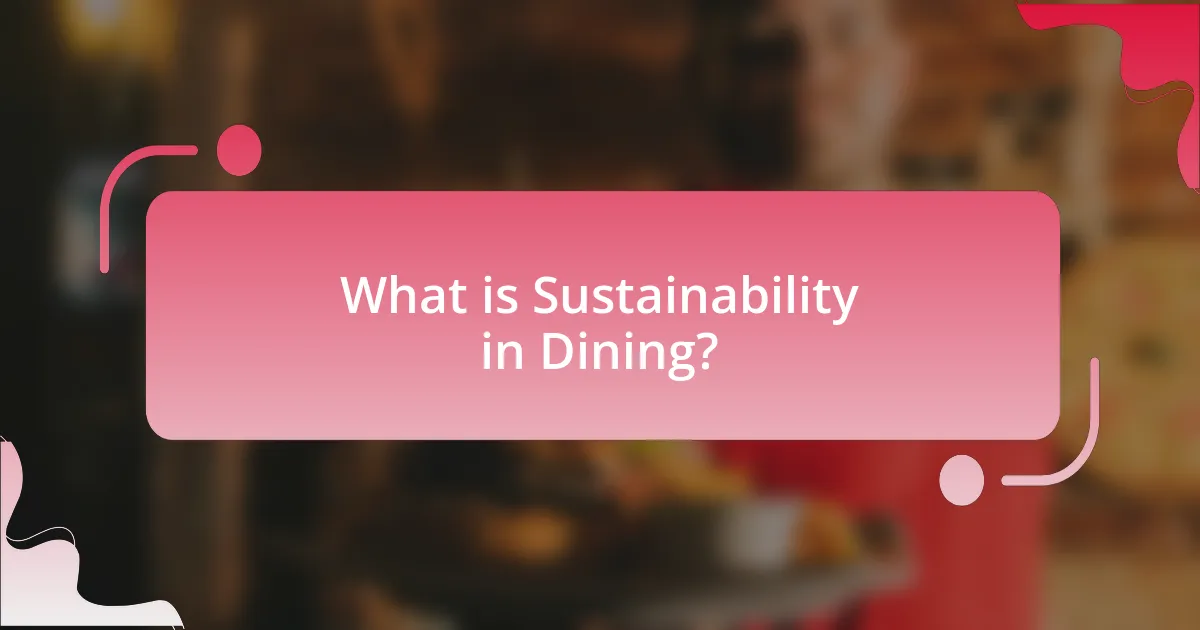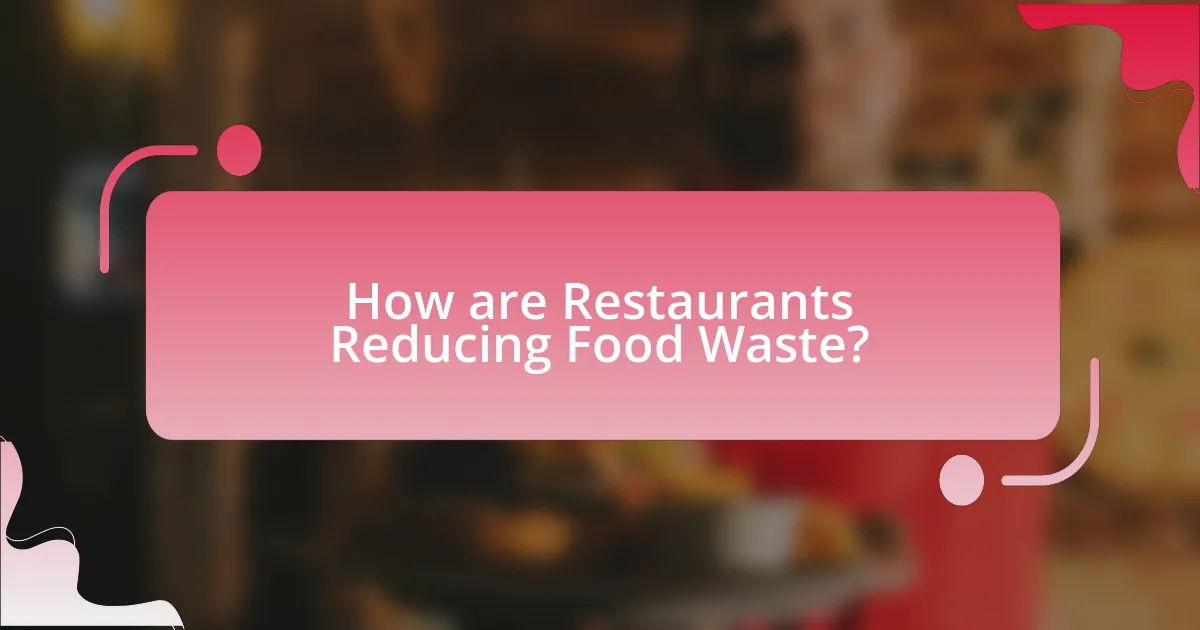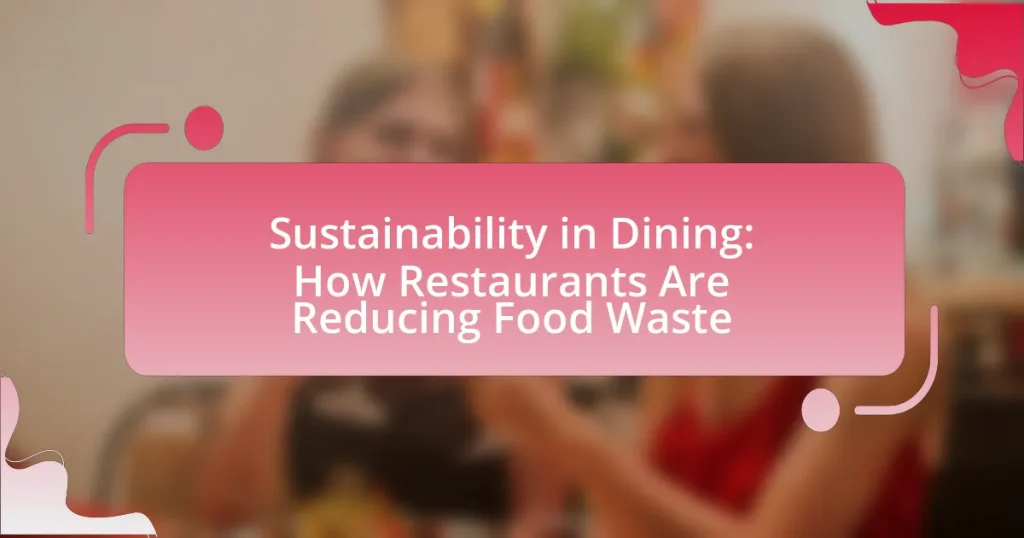Sustainability in dining encompasses practices aimed at minimizing environmental impact while promoting social responsibility and economic viability within the food service industry. This article explores how restaurants are adopting sustainable practices, particularly in reducing food waste, which constitutes a significant portion of their operational challenges. Key strategies discussed include sourcing local ingredients, implementing portion control, optimizing menus, and utilizing technology for inventory management. The article also highlights the economic, environmental, and social benefits of reducing food waste, emphasizing its importance for both restaurant profitability and community well-being.

What is Sustainability in Dining?
Sustainability in dining refers to practices that minimize environmental impact while promoting social responsibility and economic viability in food service. This includes sourcing ingredients locally, reducing food waste, and implementing eco-friendly practices, which collectively contribute to a more sustainable food system. For instance, restaurants that prioritize local sourcing can reduce transportation emissions and support local economies, while those that implement waste reduction strategies can significantly decrease the amount of food sent to landfills, which accounted for approximately 30-40% of the total food supply in the United States as reported by the USDA.
How is sustainability defined in the context of dining?
Sustainability in the context of dining is defined as the practice of sourcing, preparing, and serving food in a manner that minimizes environmental impact while promoting social equity and economic viability. This includes using locally sourced ingredients to reduce carbon footprints, implementing waste reduction strategies such as composting and recycling, and ensuring fair labor practices within the supply chain. For instance, a study by the Food and Agriculture Organization highlights that sustainable dining practices can significantly decrease food waste, which accounts for approximately one-third of all food produced globally.
What are the key principles of sustainable dining practices?
The key principles of sustainable dining practices include sourcing local and seasonal ingredients, minimizing food waste, and prioritizing environmentally friendly cooking methods. Sourcing local and seasonal ingredients reduces transportation emissions and supports local economies, while minimizing food waste involves strategies such as portion control and utilizing leftovers creatively. Prioritizing environmentally friendly cooking methods, such as energy-efficient appliances and sustainable sourcing, further enhances the sustainability of dining practices. These principles collectively contribute to a more sustainable food system, as evidenced by studies showing that local sourcing can reduce carbon footprints by up to 30%.
Why is sustainability important for the restaurant industry?
Sustainability is crucial for the restaurant industry because it directly impacts environmental conservation, economic viability, and social responsibility. Restaurants that adopt sustainable practices can significantly reduce food waste, which accounts for approximately 30-40% of the food supply in the United States, according to the USDA. By implementing strategies such as sourcing local ingredients, optimizing inventory management, and composting organic waste, restaurants not only minimize their ecological footprint but also enhance their brand reputation and customer loyalty. Furthermore, sustainable practices can lead to cost savings; for instance, reducing food waste can save restaurants an average of $1,500 per year for every seat in the establishment. Thus, sustainability is essential for the restaurant industry to thrive in a competitive market while contributing positively to the environment and society.
What role does food waste play in sustainability?
Food waste significantly undermines sustainability by contributing to greenhouse gas emissions and resource depletion. When food is discarded, the energy, water, and labor used in its production are wasted, exacerbating environmental issues. According to the Food and Agriculture Organization, approximately one-third of all food produced globally is wasted, which translates to about 1.3 billion tons annually. This waste not only increases methane emissions from landfills but also represents a loss of the resources used to produce that food, such as water and land. Therefore, reducing food waste is essential for enhancing sustainability in dining and mitigating climate change impacts.
How much food waste is generated by restaurants annually?
Restaurants generate approximately 11.4 million tons of food waste annually in the United States. This figure represents about 30-40% of the total food supply, according to the U.S. Environmental Protection Agency. The significant volume of waste highlights the challenges restaurants face in managing food inventory and portion sizes effectively.
What are the environmental impacts of food waste in dining?
Food waste in dining significantly contributes to environmental degradation, primarily through increased greenhouse gas emissions and resource depletion. When food is discarded, it often ends up in landfills, where it decomposes anaerobically, producing methane, a greenhouse gas that is over 25 times more potent than carbon dioxide over a 100-year period. According to the Food and Agriculture Organization, approximately one-third of all food produced globally is wasted, which translates to about 1.3 billion tons annually. This waste not only exacerbates climate change but also represents a waste of the water, energy, and labor that went into producing, processing, and transporting that food. Furthermore, food waste contributes to biodiversity loss as agricultural land is used to grow food that is ultimately not consumed.

How are Restaurants Reducing Food Waste?
Restaurants are reducing food waste by implementing strategies such as portion control, menu optimization, and food donation programs. Portion control helps minimize excess food served to customers, while menu optimization focuses on using ingredients across multiple dishes to reduce surplus. Additionally, many restaurants partner with local charities to donate surplus food, which not only decreases waste but also supports community needs. According to the Food Waste Reduction Toolkit by the USDA, restaurants can cut food waste by up to 50% through these practices, demonstrating their effectiveness in promoting sustainability.
What strategies are restaurants implementing to minimize food waste?
Restaurants are implementing several strategies to minimize food waste, including portion control, menu optimization, and food donation programs. By adjusting portion sizes, restaurants can reduce the amount of uneaten food left on plates, which directly decreases waste. Menu optimization involves designing dishes that utilize ingredients across multiple offerings, ensuring that surplus items are used efficiently. Additionally, many restaurants partner with local food banks and charities to donate surplus food, which not only reduces waste but also supports community needs. According to a report by the Food Waste Reduction Alliance, restaurants that adopt these strategies can significantly lower their food waste by up to 30%.
How does menu design contribute to reducing food waste?
Menu design contributes to reducing food waste by strategically curating offerings that align with customer preferences and portion sizes. By analyzing sales data and customer feedback, restaurants can create menus that feature popular items in appropriate quantities, minimizing the likelihood of unsold food. Research indicates that menus designed with seasonal ingredients and smaller portion options can lead to a significant decrease in waste, as these practices encourage consumption of fresh produce and reduce leftovers. For instance, a study published in the Journal of Cleaner Production found that restaurants implementing targeted menu designs reduced food waste by up to 30%.
What role does portion control play in waste reduction?
Portion control significantly reduces food waste by ensuring that servings align with consumer appetite and dietary needs. By offering appropriately sized portions, restaurants can minimize the likelihood of uneaten food being discarded. Research indicates that when portion sizes are reduced, food waste can decrease by up to 30%, as consumers are less likely to leave food on their plates. This practice not only conserves resources but also promotes sustainable dining habits, contributing to overall waste reduction efforts in the food service industry.
How are technology and innovation aiding in waste reduction?
Technology and innovation are significantly aiding in waste reduction by enabling more efficient inventory management and food tracking systems in restaurants. For instance, advanced software solutions utilize data analytics to predict customer demand accurately, which helps minimize overproduction and spoilage. According to a study by the Food Waste Reduction Alliance, implementing such technologies can reduce food waste by up to 30%. Additionally, innovations like smart sensors and IoT devices monitor food freshness and storage conditions, ensuring that perishable items are used before they expire. These technological advancements not only streamline operations but also contribute to a more sustainable dining environment by effectively reducing food waste.
What technologies are being used to track and manage food waste?
Technologies used to track and manage food waste include IoT sensors, data analytics software, and mobile applications. IoT sensors monitor food storage conditions and track expiration dates, providing real-time data to reduce spoilage. Data analytics software analyzes waste patterns, helping restaurants identify areas for improvement and optimize inventory management. Mobile applications facilitate communication between staff, allowing for better tracking of food usage and waste. These technologies collectively enhance operational efficiency and contribute to sustainability efforts in the dining industry.
How can apps and software help restaurants optimize inventory?
Apps and software can help restaurants optimize inventory by providing real-time tracking and analytics of stock levels, which reduces food waste and improves ordering efficiency. These digital tools enable restaurants to monitor inventory usage patterns, forecast demand based on historical data, and automate reordering processes. For instance, a study by the Food Waste Reduction Alliance found that implementing inventory management software can lead to a 20% reduction in food waste, demonstrating the effectiveness of technology in enhancing operational efficiency and sustainability in dining.

What are the Benefits of Reducing Food Waste in Restaurants?
Reducing food waste in restaurants leads to significant economic, environmental, and social benefits. Economically, restaurants can save up to 30% of their food costs by minimizing waste, as reported by the Food Waste Reduction Toolkit from the U.S. Environmental Protection Agency. Environmentally, reducing food waste decreases greenhouse gas emissions, as food waste in landfills produces methane, a potent greenhouse gas; the Environmental Protection Agency estimates that food waste accounts for approximately 24% of municipal solid waste. Socially, reducing food waste can enhance a restaurant’s reputation and attract environmentally conscious customers, contributing to a positive brand image and customer loyalty.
How does reducing food waste impact a restaurant’s bottom line?
Reducing food waste positively impacts a restaurant’s bottom line by lowering costs associated with purchasing, storing, and disposing of excess food. For instance, a study by the Food Waste Reduction Toolkit indicates that restaurants can save up to 20% on food costs by implementing waste reduction strategies. Additionally, minimizing waste can enhance operational efficiency, allowing staff to focus on service rather than waste management. This not only improves customer satisfaction but can also lead to increased sales, as a more efficient operation often results in better dining experiences.
What cost savings can be achieved through waste reduction?
Cost savings achieved through waste reduction can be substantial, with restaurants reporting reductions in food costs by up to 30%. By minimizing food waste, establishments can lower their purchasing expenses, as less food needs to be bought to meet demand. For instance, a study by the Food Waste Reduction Toolkit indicated that restaurants implementing waste reduction strategies saved an average of $7,000 annually. Additionally, reducing waste can decrease disposal costs, as less waste leads to lower waste management fees. Overall, effective waste reduction not only enhances profitability but also contributes to sustainability efforts in the dining industry.
How does waste reduction enhance a restaurant’s reputation?
Waste reduction enhances a restaurant’s reputation by demonstrating a commitment to sustainability and social responsibility. Restaurants that actively reduce waste attract environmentally conscious customers, leading to increased customer loyalty and positive word-of-mouth. According to a 2021 study by the Food Waste Reduction Alliance, 72% of consumers prefer dining at establishments that prioritize sustainability practices. This preference translates into higher patronage and can improve a restaurant’s overall market position. Additionally, effective waste management can lead to cost savings, which can be reinvested into quality ingredients or customer experience, further enhancing the restaurant’s appeal.
What are the social and environmental benefits of reducing food waste?
Reducing food waste provides significant social and environmental benefits. Socially, it enhances food security by redirecting surplus food to those in need, thereby addressing hunger; for instance, organizations like Feeding America report that 35 million people face food insecurity in the U.S. Environmentally, minimizing food waste reduces greenhouse gas emissions, as decomposing food in landfills generates methane, a potent greenhouse gas. According to the Food and Agriculture Organization, food waste contributes to about 8-10% of global greenhouse gas emissions. Thus, reducing food waste not only supports vulnerable populations but also mitigates climate change impacts.
How does food waste reduction contribute to community well-being?
Food waste reduction contributes to community well-being by enhancing food security and promoting environmental sustainability. When restaurants and communities minimize food waste, they can redirect surplus food to those in need, thereby alleviating hunger. For instance, organizations like City Harvest report that food recovery initiatives can provide millions of meals to food-insecure populations, significantly improving access to nutritious food. Additionally, reducing food waste lowers greenhouse gas emissions, which benefits public health and the environment. According to the Food and Agriculture Organization, approximately one-third of food produced globally is wasted, contributing to climate change. Therefore, effective food waste reduction strategies not only support vulnerable community members but also foster a healthier ecosystem.
What are the long-term environmental benefits of sustainable dining practices?
Sustainable dining practices lead to significant long-term environmental benefits, primarily by reducing food waste and conserving resources. By implementing strategies such as sourcing local ingredients, restaurants minimize transportation emissions and support local economies, which in turn reduces the carbon footprint associated with food production and distribution. Additionally, sustainable dining often involves composting organic waste, which can divert up to 30% of waste from landfills, thereby decreasing methane emissions—a potent greenhouse gas. Furthermore, these practices promote biodiversity by encouraging the use of seasonal and diverse crops, which helps maintain healthy ecosystems. Studies indicate that sustainable dining can reduce overall resource consumption by up to 50%, highlighting its effectiveness in fostering a more sustainable food system.
What are some best practices for restaurants to implement?
Restaurants should implement practices such as portion control, menu optimization, and food donation programs to effectively reduce food waste. Portion control minimizes excess food served to customers, thereby decreasing leftovers. Menu optimization involves designing dishes that utilize similar ingredients, which helps in managing inventory and reducing spoilage. Food donation programs allow restaurants to give surplus food to local charities, ensuring that edible food does not go to waste. According to the Food Waste Reduction Toolkit by the USDA, implementing these strategies can lead to a significant decrease in food waste, benefiting both the environment and the restaurant’s bottom line.
How can restaurants educate staff about food waste reduction?
Restaurants can educate staff about food waste reduction through comprehensive training programs that include workshops, hands-on activities, and informational resources. These programs should cover the importance of minimizing food waste, techniques for proper food storage, portion control, and creative ways to repurpose leftovers. Research indicates that effective training can lead to a 20-30% reduction in food waste in food service operations, demonstrating the impact of informed staff on sustainability efforts.
What partnerships can restaurants form to further reduce waste?
Restaurants can form partnerships with local farms, food banks, and waste management companies to further reduce waste. Collaborating with local farms allows restaurants to source ingredients that are surplus or imperfect, minimizing food waste at the production level. Partnering with food banks enables restaurants to donate excess food, which can help feed those in need while reducing waste. Additionally, working with waste management companies can facilitate composting and recycling programs, ensuring that organic waste is processed sustainably. These partnerships not only contribute to waste reduction but also promote community engagement and sustainability.














